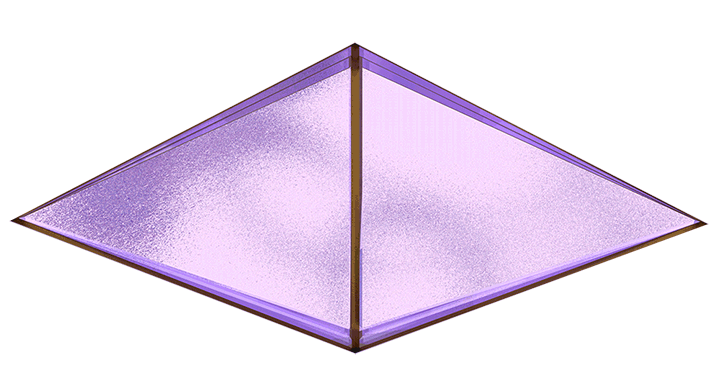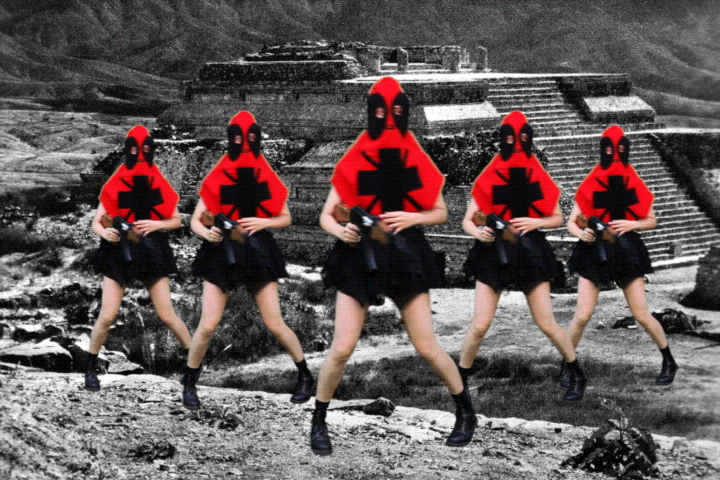
Hugo Moreno, “Art Department Walls”, 2015, one of nine animated GIFs drawn from Moreno’s video “Art Department Walls”
Providence College—Galleries Launches Inaugural Online Exhibition
Geographically Indeterminate Fantasies: The Animated GIF as Place
Curated by Art F City critics Paddy Johnson, Michael Anthony Farley & Rea McNamara.
VIEW THE EXHIBITION: pcgalleries.providence.edu/GIF
As those subscribed to our mailing list will already know, today Providence College—Galleries launched its inaugural online exhibition “Geographically Indeterminate Fantasies: The Animated GIF as Place”. Curated by the Art F City team. Michael Anthony Farley, Paddy Johnson, and Rea McNamara, the show is the result of six months worth of planning, development and careful consideration. We are extremely proud of it.
Given that the press release has already gone out, we’re using the blog as the publishing platform for our curatorial essay. We hope it will give viewers a window into the sense of wonder we often have looking at these works.
Artists include: Peter Burr, Petra Cortright, Milton Melvin Croissant III, Elektra KB, Claire L Evans, Faith Holland, Dina Kelberman, Kidmograph (Gustavo Torres), Sara Ludy, Lauren Pelc-McArthur, Alex McLeod, Ying Miao, Jonathan Monaghan, Hugo Moreno, Brenna Murphy, Eva Papamargariti, Robby Rackleff, Sam Rolfes, Nicolas Sassoon, Jacolby Satterwhite, Hito Steyerl, Tough Guy Mountain, Małgosia Woźnica (V5MT), Wickerham & Lomax, Clement Valla and Giselle Zatonyl.

Image: Giselle Zatonyl, “Modular Landscape (Kyplon)”, 2016, animated GIFs
Geographically Indeterminate Fantasies: The Animated GIF as Place looks at artists who use GIFs to present fully realized environments—architectural spaces, alternate realities, cyberspace utopias, cyberpunk dystopias or personal escapes. Organized by GIFs as web pages, GIFs as stand-alone images and GIFs as series, the show tracks a number of themes: the city as a network of personal and social spaces, the personification of the landscape as avatar, the browser, or more broadly, the digital as space and ubiquitous battlefield.
With this inaugural online exhibition for Providence College—Galleries, we have assembled artist-designed GIF environments ranging from 3D rendered spaces to collage and video-sourced footage. Also on view are newly commissioned landscape GIFs by Jonathan Monaghan, Brenna Murphy, Clement Valla, and Giselle Zatonyl, as well as a related reading list by Claire Evans. Featuring over 25 artists and displaying more than 100 animated GIFs, Geographically Indeterminate Fantasies, serves as both a vision of artists’ new worlds, and as a document of our own aspirations and anxieties.
Artists can now become their own architects, urban planners or benevolent dictators of alternate realities. Whether establishing an allegorical world to confront political issues or appropriating and accumulating imagery that surrounds them, landscape GIFs often reflect the generational anxieties of their makers: powerlessness in the face of climate change, a nearly-nomadic lifestyle as a result of gentrification and other social issues, and ever-accelerating changes in the natural and built environment.
The beauty of the GIF, though, is that it exists outside of these realities. Now 28 years old, the GIF is the aging poster child for the placeless image. Standardized to slip in and out of various software, HTML pages, projectors and mobile phone screens, it thrives in the unbounded space of the Internet. The GIF is often referred to as a type of “micro-cinema,” but in reality it holds more in common with proto-cinematic art forms, such as the stained-glass window, sequential mosaic or architectural procession. Like these, it can tell a story but is most effective at inspiring wonder.

Elektra KB, Cathara Insurgency Protecting an Autonomous Liberated Territory, 2014, animated GIF
For many of the artists in this show, space itself is the story. Whether the barren black and white landscapes of Peter Burr or a futuristic city by Hugo Moreno, architecture, landscapes and movement within spaces are the subject. This breaks from a lot of art, theatre and cinematic history, where landscapes simply provide the context within which other narratives unfold.
Sometimes, a GIF world can provide an outlet for acting out aggressions, as in the militaristic battle scenes of Robby Rackleff and Elektra KB. In Rackleff’s imagined first-person shooter games, there is a sense of frustration with the real world’s lack of excitement with video games, which in many ways shape adolescent worldviews. Here, Rackleff plays his gloriously over-the-top protagonist “Blue Leader,” navigating a world of archetypal tropes with infinite lives and no consequences. Elektra KB’s fantastical world The Theocratic Republic of Gaiaserves as an allegorical homeland created from a sense of necessity—the artist has spent most of her life as a migrant, living between politically unstable or repressive nations. Anxieties over oppression—from religious authority to gender/racial inequality—are battled out in KB’s fictional country by a group of masked rebel women who are metaphorically marching to war to exact revenge on political paranoia over “the other.” KB has perhaps best summarized the urgency of her militant aesthetic by quoting Frantz Fanon from his 1961 book The Wretched of the Earth: “Either one must remain terrified or become terrifying.”
Rather than directly inhabiting their constructed environments, other artists insert themselves or the viewer as avatars or surrogates. Faith Holland’s Visual Orgasms personifies a collage of waterfalls as an endless moment of sexual ecstasy. Wickerham & Lomax allow the viewer to “cruise” a dim, hazy nightclub as a series of personalized, absurdly specific cursors—a reference to the implied interactivity of customizable web experiences. Here they circle a round bar, which could be seen as an eerily empty queer panopticon. Whoever might use the space would do so to see and be seen, bringing into question the way identity is constructed and portrayed both in gay nightlife and online.

Milton Melvin Croissant III also leads us through familiar interiors made uncanny by the absence of users. A sterile classroom, a shuttered video rental store, and the aftermath of a suburban house party suggest a surplus of disposable architecture, all endlessly looping like so much of sprawl. In Eva Papamargariti’s GIFs, the cycle of consumption takes on a claustrophobic air. Monuments to sneakers and flat screen TVs endlessly rise, while architectural models and kitsch sink into a cluttered fish tank. There is a lot of stuff in the world, and Papamargariti suggests there will only be more of it. But there is a more utopian feel to the architectural models in the work of Małgosia Woźnica (V5MT). A series of postmodern building blocks expands and contracts in a limitless grid, suggesting houses, towers and cityscapes that could playfully adapt to different uses. The cityscapes of Kidmograph (Gustavo Torres) similarly consider “the grid” (in both the cyberpunk and architectural sense) as site of potentiality, a neon hybrid of data and urbanism ripped from the pages of a William Gibson novel. Dina Kelberman’s Doors more directly appropriate sci-fi imagery—she’s collected clips of the holodeck from Star Trek opening and closing. The mutable fantasy space seems forever malfunctioning like a skipping record.
Again, the digital leisure space feels slightly “off” in the work of Sara Ludy. Her Beaches series presents uncanny simulacra of empty resort destinations. Conversely, Nicolas Sassoon invites the viewer to scroll through an idealized artist studio. Tough Guy Mountain also seems to beckon us “to step into the office,” where live/work spaces have been reduced to pastel dorm-like floating platforms in a crisp white void. A similarly cheery aesthetic makes up Alex McLeod’s worlds, where cartoon-like skyscrapers bounce around spotless cities. The chaotic, semi-urban environments of Sam Rolfes, however, embrace disorder. There, one might encounter a pair of chattering teeth next to high rise-esque forms that seem to hang at an impossible angle. The digital potential to ignore the laws of physics or logic of representation is embraced fully in a world of sheer fantasy. And in the abstract GIFs of Lauren Pelc-McArthur, allusions to the landscape dissolve almost entirely. One straddles the line between slowly shifting oil painting and a seascape of distorted video.
Hito Steyerl’s GIFs reflect the central thesis of her well-known video installations and writing; that data, narrative and space are as malleable as water, and that violence, money and art are always connected. For this show, we have included only her writings imposed against a single enlarged animated GIF of water. Here, the GIF mimics the mutability of its subject and softens the palpable sense of anxiety that lives within her work.

Petra Cortright, System Landscapes, 2007, animated GIFs
Petra Cortright’s GIFs similarly employ the environment of the computer as landscape. This suite of 40 GIFs begins with a series of large broken windows showing moving aerial shots and digital maps in editing software followed by various botanical arrangements. By the end, the windows have become tiny. “Connected” reads one, followed by “Disconnected.” Then “Cloud Forest” before a seemingly endless number of tiny squares with landscapes, each reading “Away Message,” leading up to “I’m back!” Perhaps indicative of its 2007 origin, the artwork’s flickering messages seem a perfect analogue for the broken connection. A stable Internet connection is the most important tool for digital artists. But in Ying Miao’s browser, that connection seems in constant peril. Responding to the Chinese government’s censorship of the net, a bucolic park is inundated with rain, and deserts show few signs of life as the authorities deny attempts to access sites such as Wikipedia.
Finally, we commissioned new landscape GIFs from four artists whose overall body of work we feel has a pre-existing relationship with the other selected GIFs. Jonathan Monaghan’s GIFs are glimpses of a cyclical narrative. A golden stag navigates a surreal landscape to impregnate a floating pavilion. Within, the stag is reborn from the cushions of a modern sofa. Giselle Zatonyl likewise takes the viewer on a cinematic ride through the alien Modular Landscape Kyplon, wherein from a ship’s portholes, we observe a passing landscape of purple seas and floating organic architecture. In Clement Valla’s work, representations of our own planet are quilted into a kaleidoscopic grid that questions Google Earth’s all-seeing eye. Topography spirals and warps, revealing distortions within the archive. Brenna Murphy’s equally dizzying GIFs suggest some massive networked architecture. These impossible mega-structures seem to be in a state of flux, made more disorienting by our changing point of view.


{ 2 trackbacks }